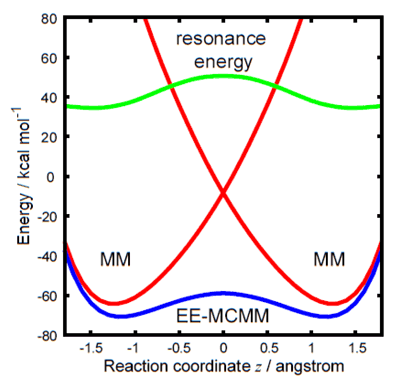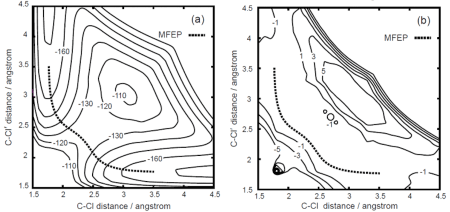03/03/2008
Force Fields for Complex Reactions
Recent research from the group of Professor Don Truhlar.

Combined quantum mechanical
and molecular mechanical (QM/MM) methods have provided powerful means for
studying chemical reactions in condensed phases such as liquids, enzymes,
and solids. In these approaches, the reaction center is described quantum
mechanically, while the surroundings are treated by using a molecular mechanics
force field. However, the high computational cost of quantum mechanical
(QM) calculations prevents carrying out QM/MM molecular dynamics simulations
with reliable accuracy and adequate sampling.
In order to reduce the
computational cost of the QM calculation, postdoctoral research associate
Masahiro Higashi and Regents Professor Donald G. Truhlar* have
developed a new method called electrostatically embedded multi-configuration
molecular mechanics (EE-MCMM) for generating global potential energy surfaces
(PESs) in the presence of an electrostatic potential. MCMM describes the
global PES of a condensed-phase reaction with electronic structure information,
in particular energies and partial charge distributions, obtained in the
gas phase at selected geometries. Because this new method is efficient,
high-level QM calculations can be used in QM/MM methods.
The result is a key step toward studying chemical reactions in condensed phases
with high accuracy.

- Equipotential contour plot of the PES
of the reaction
 in aqueous solution calculated by
the EE-MCMM method. The minimum free energy path is shown as a dashed curve. in aqueous solution calculated by
the EE-MCMM method. The minimum free energy path is shown as a dashed curve.
- Equipotential contour plot of the difference between the PESs calculated by the EE-MCMM
and direct methods. Notice that the EE-MCMM representation obtained from gas-phase calculations is accurate
for this liquid-phase reaction to 1 kcal/mol or better over a wide range.
* Masahiro
Higashi and Donald G. Truhlar, &dlquo;Electrostatically Embedded Multiconfiguration
Molecular Mechanics Based on the Combined Density Functional and Molecular
Mechanical Method,&drquo; Journal of Chemical Theory and Computation,
to be published.
|